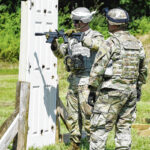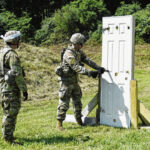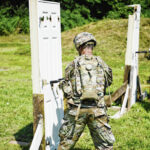
A member of the Indiana National Guard 776 Brigade Engineer Battalion uses a breaching shotgun to practice shooting the hinges off of doors during a special training at Camp Atterbury on Aug. 19. The battalion worked on demolition and clearing barriers during the week-long training at the southern Johnson County base.
Ryan Trares | Daily Journal
CAMP ATTERBURY — Explosions and gunshots echoed across the field.
Deep inside one of the training ranges at Camp Atterbury, members of the Indiana National Guard 776 Brigade Engineer Battalion were engaging in various forms of demolition. Some were using battering rams and other tools to break down doors. Others were practicing shooting the hinges off of doors to enter a building.
Engineers set up explosive charges set up in another portion of the range, working on the proper protocol for detonation.
“Mechanical, you’re working with tools. With ballistic, you have your breaching shotgun, and then there are explosives,” said Pvt. Christopher Mohr, a member of the unit from Fort Wayne. “It’s our specialized training — it’s what we specialize in. They’re doing their own thing, we specialize in getting into buildings or making things unpassable.”
Over the course of a week at Camp Atterbury, this group of National Guard engineers honed the skills that would be necessary for urban warfare situations. They learned the proper protocol and approach to different situations, then applied them at the training ranges at the camp.
National Guard troops from Indiana are typically deployed for peace-time domestic missions such as responding to a natural disaster, such as a large-scale flood or earthquake, or a highly destructive tornado. During the pandemic, Gov. Eric Holcomb called them up to provide extra hands in hospitals and long-term facilities. However, troops can be called into combat overseas, as they were during the wars in Iraq and Afghanistan.
Through fine-tuning and practice, they prepare to help their fellow infantry soldiers breach buildings, overcome obstacles and achieve their mission when activated.
“Us staying proficient, especially with breaching, means (other infantry) don’t have to worry about some of the aspects of our job,” said 1st Sgt. Corey Rhude of the brigade’s Bravo Company. “If we’re doing our job, they don’t have to do it.”
The National Guard’s 776 Brigade Engineer Battalion follows the 76th Infantry Brigade, which includes infantry battalions, artillery, cavalry and support.
Part of their responsibility is blowing up, breaking through or getting rid of obstacles on the battlefield.
“We as engineers, we’re very diverse. We actually support our maneuverability people. When we support them, what that does is allow them to focus more on their infantry and maneuver tasks,” Rhude said.
Out in the field, the unit worked on breaching doors and getting into buildings. Some used shotguns to blast off hinges. Others set charges to explode and allow passage through the door.
Mechanical battering equipment let the soldiers force their way through the barrier.
“All the different types of breaching is important. We don’t want to overuse resources for something where it’s not needed, so that’s why we use the mechanical and ballistic training,” Rhude said. “We try to attack the right target with the right asset.”
A portion of their training was set aside for using heavy explosives such as shaped charges to demolish larger land features.
“We specialize in getting from Point A to Point B as quickly as possible and as safely as possible, and that’s what we’re working on all week,” said Spc. Francis Henry, a member of the unit from Hancock County.
The training also allowed the units to work with specialized equipment used to clear explosives and other barriers from roadways. Known as a Panther, the vehicle is a medium mine-protected vehicle, which means it is armored against mines and other explosives that could be used to ambush troops.
The vehicle leads the way for advancing troops, searching for bombs and clearing them safely. A specialized camera can be mounted on an extending arm and raised nearly 100 feet into the air, giving troops the ability to see miles away.
Another feature allows a robot, operated from inside the vehicle, to be lowered onto the ground to investigate suspicious items.
“It’s so we don’t have to put boots on the ground. If we find something weird, instead of sending someone on foot, we’ll drive this little robot down there to interrogate it. It just keeps everyone safer,” said Sgt. Ryan Jansen, a combat engineer from LaPorte.
Despite the long days in heavy equipment out in the mid-August heat, the exercises had been overwhelmingly valuable, said Spc. Christopher Davis, a member of the unit from central Indiana.
“It’s hot, but for the most part, it’s been really good training. We’ve done training in first aid casualty care, land navigation, then we have heavy demolitions coming up,” he said.
Most importantly, unit leadership can be confident that if the National Guard engineers need to put these skills to use sometime in a combat situation, they’ll be properly prepared to do so.
“If we ever have to come out and do this in real life, the soldiers are trained and it’s less of a risk,” Rhude said.
A member of the Indiana National Guard 776 Brigade Engineer Battalion uses a breaching shotgun to practice shooting the hinges off of doors during a special training at Camp Atterbury on Aug. 19. The battalion worked on demolition and clearing barriers during the week-long training at the southern Johnson County base.
Ryan Trares | Daily Journal
A member of the Indiana National Guard 776 Brigade Engineer Battalion receives instruction on using a breaching shotgun to break down doors during a special training at Camp Atterbury on Aug. 19. The battalion worked on demolition and clearing barriers during the week-long training at the southern Johnson County base.
Ryan Trares | Daily Journal
Members of the Indiana National Guard 776 Brigade Engineer Battalion practice using breaching shotguns to break down doors during a special training at Camp Atterbury on Aug. 19. The battalion worked on demolition and clearing barriers during the week-long training at the southern Johnson County base.
Ryan Trares | Daily Journal
A member of the Indiana National Guard 776 Brigade Engineer Battalion uses a breaching shotgun to practice shooting the hinges off of doors during a special training at Camp Atterbury on Aug. 19. The battalion worked on demolition and clearing barriers during the week-long training at the southern Johnson County base.
Ryan Trares | Daily Journal
Pieces of wooden explode from a door as a member of the Indiana National Guard 776 Brigade Engineer Battalion practices using a breaching shotgun to shoot off hinges during a special training at Camp Atterbury on Aug. 19. The battalion worked on demolition and clearing barriers during the week-long training at the southern Johnson County base.
Ryan Trares | Daily Journal
Members of the Indiana National Guard 776 Brigade Engineer Battalion practice using breaching shotguns to break down doors during a special training at Camp Atterbury on Aug. 19. The battalion worked on demolition and clearing barriers during the week-long training at the southern Johnson County base.
Ryan Trares | Daily Journal
Members of the Indiana National Guard 776 Brigade Engineer Battalion receive instruction on using breaching shotguns to break down doors during a special training at Camp Atterbury on Aug. 19. The battalion worked on demolition and clearing barriers during the week-long training at the southern Johnson County base.
Ryan Trares | Daily Journal
Pieces of wooden explode from a door as a member of the Indiana National Guard 776 Brigade Engineer Battalion practices using a breaching shotguns to shoot off hinges during a special training at Camp Atterbury on Aug. 19. The battalion worked on demolition and clearing barriers during the week-long training at the southern Johnson County base.
Ryan Trares | Daily Journal
A member of the Indiana National Guard 776 Brigade Engineer Battalion uses a breaching shotgun to practice shooting the hinges off of doors during a special training at Camp Atterbury on Aug. 19. The battalion worked on demolition and clearing barriers during the week-long training at the southern Johnson County base.
Ryan Trares | Daily Journal













